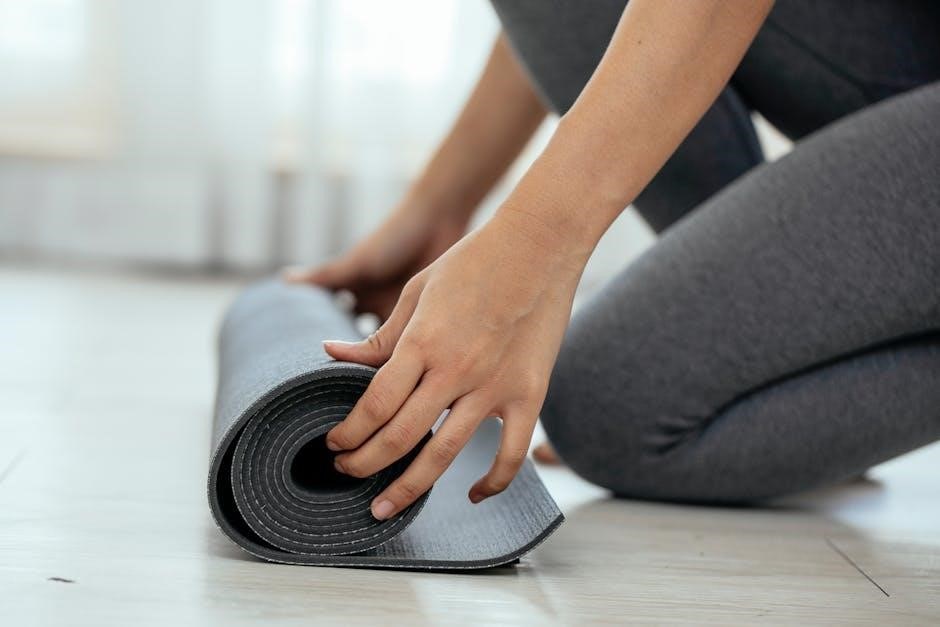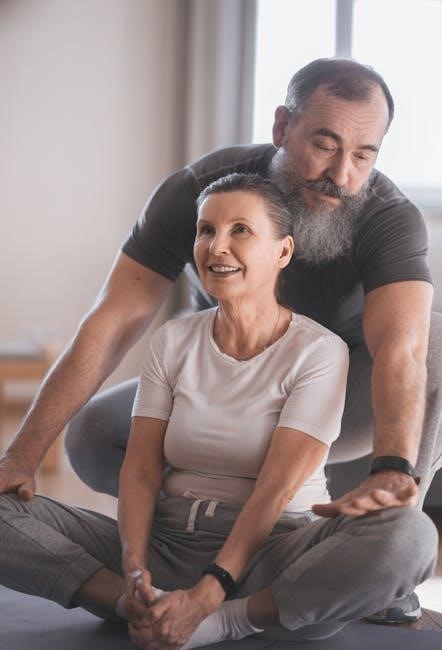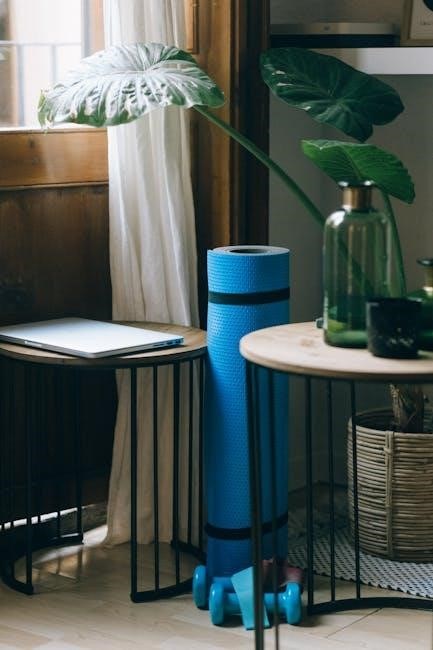A gym mat is a padded surface used for comfort and safety during exercises. Made from materials like high-density foam or rubber, they provide cushioning and support. Versatile for home or commercial use, gym mats prevent injuries by offering shock absorption and grip. Ideal for yoga, Pilates, strength training, and stretching, they promote hygiene and proper form during workouts.
1.1 Importance of Gym Mats in Workouts
Gym mats are essential for preventing injuries by providing cushioning and support. They enhance comfort during floor exercises like yoga or Pilates. Mats also promote hygiene and offer a slip-resistant surface, ensuring safety. Their versatility allows for a variety of workouts, making them a crucial tool for both home and gym environments, improving overall performance.
1.2 Brief History of Gym Mats
Gym mats have evolved significantly since their inception in ancient civilizations. Early mats were made from natural fibers like cotton and jute, providing basic cushioning. Modern mats now use advanced materials such as high-density foam and rubber, offering improved durability and hygiene. Their design has adapted to meet the needs of diverse exercises, ensuring optimal performance and safety for users today.
Types of Gym Mats
Gym mats vary to suit different needs, including home, commercial, and specialized options. Home mats are lightweight and versatile, while commercial mats are durable for heavy use. Specialized mats cater to specific exercises like yoga or Pilates, offering features like non-slip surfaces and eco-friendly materials.
2.1 Home Gym Mats
Home gym mats are lightweight and versatile, designed for personal use. They feature non-slip textures and cushioning for comfort during yoga, Pilates, and strength training. Made from durable materials like PVC or rubber, these mats are easy to store and ideal for small spaces and personal workouts.
2.2 Commercial Gym Mats
Commercial gym mats are thicker and more durable, designed for high-traffic environments. They offer superior cushioning and support for intense workouts, reducing noise and impact. Made from high-density materials, these mats are easy to clean and maintain, featuring anti-microbial treatments for hygiene in shared spaces.
2.3 Specialized Mats for Different Exercises
Specialized mats cater to specific exercises, enhancing performance and safety. Yoga mats offer textured surfaces for grip, while Pilates mats provide extra cushioning. Interlocking MMA mats are durable for martial arts, and thick foam mats support high-impact activities. Each design optimizes comfort, stability, and hygiene for targeted workout needs.

Benefits of Using a Gym Mat
Using a gym mat offers protection, comfort, and versatility. It prevents injuries, enhances hygiene, and provides grip. Essential for safe and effective workouts anywhere.
3.1 Cushioning and Comfort
Cushioning and comfort are key benefits of gym mats. The thick, high-density foam absorbs impact, protecting joints during exercises like yoga and Pilates. This reduces strain on knees, elbows, and spine, ensuring a comfortable workout experience while maintaining proper form and preventing fatigue. Proper cushioning enhances overall exercise performance and reduces injury risk significantly.
3.2 Hygiene and Sanitation
Gym mats require regular cleaning to maintain hygiene and prevent bacterial growth. Many mats are made from non-porous, sweat-resistant materials that simplify sanitation. Proper cleaning involves using mild detergents or sanitizers, followed by thorough drying to avoid moisture buildup. Regular maintenance ensures a clean workout environment, reducing odors and the risk of infections. Eco-friendly cleaners are often recommended for optimal results.
3.4 Versatility in Exercises
Gym mats offer versatility for various exercises, from yoga and Pilates to stretching, foam rolling, and core workouts. They provide a comfortable surface for dynamic movements, supporting both home and gym routines. Their cushioning and support make them ideal for high-impact activities and low-intensity stretches, accommodating diverse fitness needs and preferences effectively.
Safety Considerations
Gym mats prevent injuries by absorbing impact during exercises. They provide cushioning to reduce pressure on joints and offer slip resistance for stable movements. Proper mat placement and alignment are essential to avoid strains and ensure safe workouts.
4.1 Injury Prevention
Gym mats are essential for injury prevention by providing shock absorption during high-impact exercises. They protect joints from stress and reduce the risk of muscle strains. A quality mat ensures proper spinal alignment, minimizing the chance of back injuries and offering stability for dynamic movements, thereby safeguarding overall workout safety and effectiveness.
4.2 Slip Resistance
Slip resistance is a critical feature of gym mats, ensuring stability during workouts. Textured surfaces and non-slip finishes prevent accidental falls, while rubber backing enhances traction on smooth floors. This feature is vital for dynamic exercises, providing confidence and safety, especially in sweaty or high-intensity conditions, ensuring consistent grip and performance.
4.3 Proper Placement and Alignment
Proper placement and alignment of gym mats ensure a safe and effective workout. Place the mat on a clean, flat surface, ensuring it lies smooth without wrinkles. Secure edges with tape or non-slip backing to prevent movement. This ensures optimal cushioning, prevents injuries, and extends the mat’s lifespan.

Maintenance and Care
Regular cleaning with mild detergents prevents bacterial growth. Avoid harsh chemicals and ensure mats dry fully to prevent mold. Store in a cool, dry place to maintain condition and extend lifespan.
5.1 Cleaning Techniques
Use mild detergents and warm water to clean gym mats. Avoid harsh chemicals or abrasive materials that may damage the surface. Rinse thoroughly and allow mats to air dry to prevent mold. Regular cleaning prevents bacterial growth and maintains hygiene for safe and effective workouts.
5.2 Storage Tips
Store gym mats in a cool, dry place to prevent moisture buildup. Roll or fold them neatly to avoid creases. Use a storage bag or container to protect from dust and pests. Proper storage extends the lifespan and maintains the quality of the mat for future use.
5.3 Extending Mat Lifespan
Regular cleaning and proper storage are key to extending a gym mat’s lifespan. Avoid exposure to harsh chemicals or direct sunlight. Store in a cool, dry place to prevent cracking or fading. Inspect for wear and tear, and replace as needed to maintain performance and safety.

Choosing the Right Gym Mat
Selecting the right gym mat involves considering workout type, frequency, and available space. Evaluate thickness, material, and texture to ensure comfort and durability for your fitness needs.
6.1 Thickness and Density
Thickness and density determine a mat’s cushioning and support. Thicker mats (4-8mm) are ideal for high-impact exercises, while thinner ones (2-3mm) suit yoga or Pilates. Density affects durability and comfort, ensuring the mat remains firm yet flexible for optimal performance across various workout types and user preferences.
6.2 Material and Durability
Gym mats are made from durable materials like rubber, PVC, and TPE, each offering unique benefits. Rubber is eco-friendly and resilient, while TPE is flexible and easy to clean. High-quality materials ensure longevity, moisture resistance, and optimal performance for various workouts.
6.3 Size and Portability
Gym mats come in various sizes to suit different spaces and needs. Lightweight designs make them easy to carry and store. Compact options are ideal for home use, while larger mats are better for commercial settings. Portability ensures convenience, allowing users to train anywhere without compromising performance or comfort.
Common Exercises Using a Gym Mat
Gym mats are essential for yoga, Pilates, stretching, and foam rolling. They also support core exercises like planks and strength training, providing a cushioned surface for various workouts.
7.1 Yoga and Pilates
Gym mats are indispensable for yoga and Pilates, offering cushioning and support for joints during poses. They provide grip, preventing slipping and enhancing stability. Ideal for poses like tree pose or downward dog, mats ensure comfort and hygiene. Durable materials like rubber or foam are perfect for dynamic movements and breathwork exercises.
7.2 Stretching and Foam Rolling
Gym mats are essential for stretching and foam rolling, providing cushioning and support for joints. They offer a comfortable surface for exercises like hamstring stretches or chest opens. The textured surface ensures grip, while the thickness absorbs pressure, making foam rolling more effective for muscle recovery and relaxation.
7.3 Core and Strength Training
Gym mats provide stability and cushioning for core exercises like planks, sit-ups, and Russian twists. They protect joints during high-impact movements and weightlifting, ensuring comfort and preventing injuries. The non-slip surface enhances grip, allowing focused strength training without distractions, making mats indispensable for effective core workouts and overall fitness routines.
Environmental Impact
Gym mats made from eco-friendly materials like natural rubber or PVC reduce environmental harm. Sustainable manufacturing practices and recyclable designs minimize waste, promoting a greener fitness industry.
8.1 Eco-Friendly Materials
Eco-friendly gym mats are crafted from sustainable materials like natural rubber and organic cotton. These biodegradable options reduce environmental impact, offering a healthier choice for users. Free from harsh chemicals, they align with eco-conscious practices, promoting a greener fitness industry while maintaining durability and performance.
8.2 Recycling and Disposal
Proper recycling and disposal of gym mats ensure environmental sustainability. Many mats are made from recyclable materials like rubber and foam. Drop-off locations or specialized programs often accept old mats for reuse or repurposing. Avoiding landfills reduces waste, promoting eco-friendly practices and responsible resource management.
8.3 Sustainable Manufacturing Practices
Sustainable manufacturing practices in gym mat production emphasize eco-friendly materials and energy-efficient processes. Many manufacturers use biodegradable or recycled materials, reducing environmental impact. Certifications like ISO 14001 ensure adherence to environmental standards. These practices minimize waste, reduce emissions, and promote ethical labor conditions, aligning with global sustainability goals.

Innovations in Gym Mat Technology
Innovative gym mats now feature smart sensors for performance tracking, anti-microbial coatings for hygiene, and eco-friendly materials. Interlocking designs offer customizable sizes, enhancing versatility and convenience for users.
9.1 Smart Mats with Tracking Features
Smart gym mats integrate sensors to track performance metrics like heart rate, calories burned, and exercise form. Bluetooth connectivity allows syncing with apps for real-time feedback. Eco-friendly materials and interlocking designs enhance functionality, while customizable sizes improve versatility for home or commercial use, ensuring a tech-driven workout experience.
9.2 Anti-Microbial Treatments
Anti-microbial treatments on gym mats inhibit the growth of bacteria, fungi, and odors. These coatings ensure a hygienic surface, reducing the risk of infections. Eco-friendly options are available, making mats safer for long-term use while maintaining durability and performance, especially in high-traffic environments like commercial gyms.
9.3 Customizable and Interlocking Designs
Customizable gym mats allow users to tailor colors, sizes, and thicknesses to meet specific needs. Interlocking designs enable easy expansion or reconfiguration, creating seamless workout areas. These mats are ideal for both home and commercial use, offering versatility and modularity to suit diverse fitness spaces and preferences effectively while maintaining durability.
Gym mats are essential for workouts, offering comfort, safety, and versatility. Their benefits extend beyond physical support, promoting hygiene and durability. A gym mat is a practical investment for any fitness routine.
10.1 Summary of Key Points
Gym mats provide essential cushioning, support, and hygiene for workouts. They are versatile for home or commercial use, offering safety and comfort. Durable materials ensure longevity, while various sizes and thicknesses cater to different needs. A good gym mat is a vital investment for effective and injury-free exercises, enhancing overall fitness routines.
10.2 Final Thoughts on Gym Mat Usage
Gym mats are indispensable for workouts, offering cushioning, hygiene, and versatility. They protect from injuries and provide comfort, making them a crucial tool for home and commercial use. Investing in a quality mat ensures safety and enhances exercise effectiveness, promoting overall fitness and well-being and performance.
